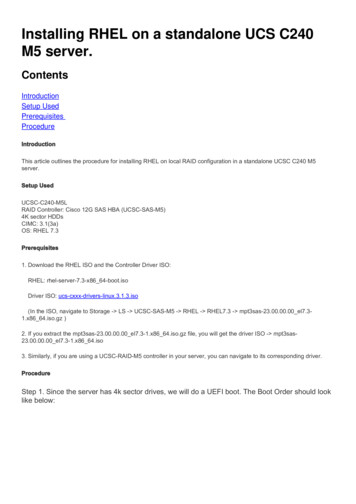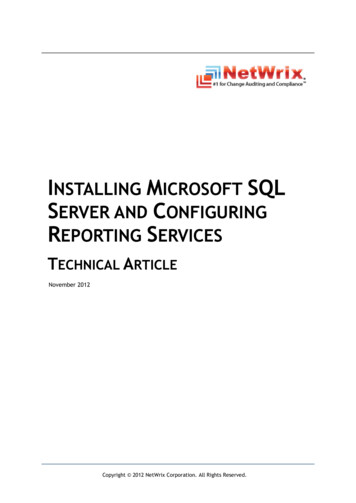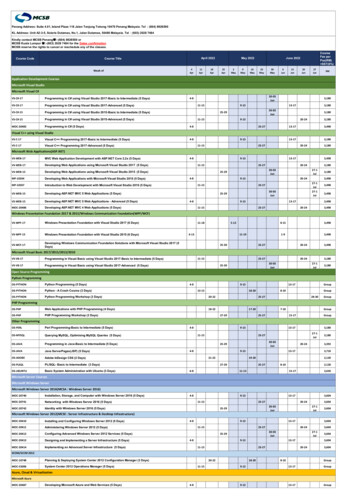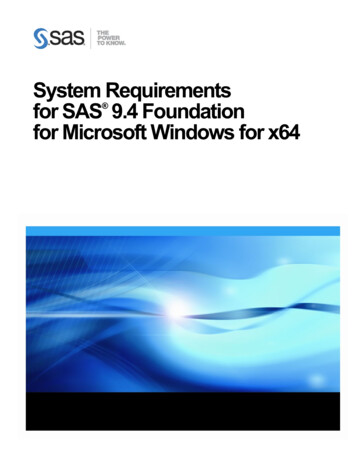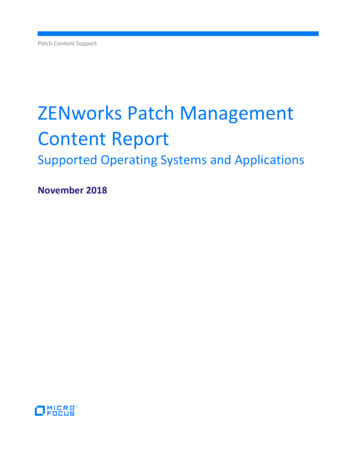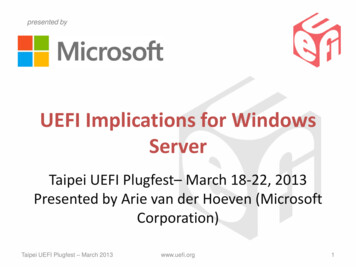
Transcription
presented byUEFI Implications for WindowsServerTaipei UEFI Plugfest– March 18-22, 2013Presented by Arie van der Hoeven (MicrosoftCorporation)Updated 2011-06-01Taipei UEFI Plugfest – March 2013www.uefi.org1
Agenda Windows Server 2012 UEFI features Boot Flows Certification Basics on Windows Server2012 UEFI Challenges UEFI Driver Signing Resources Q&A
Advantages of UEFI vs. BIOSInterfaceLegacy BIOSUEFIx86 / X64 onlyAgnosticMode16 bit (real mode)32/64 bitBoot PartitionMBR (2.2 TB limit)GPT (9.4 ZB* limit)Runtime ServicesNoYesDriver modelNoYesPOST GraphicsVGAGraphical Output Protocol(GOP)Architecture* A zettabyte is equal to 1B terabytes. The total amount of global data was expected to pass 1.2 ZB sometime during 2010.
Multicast Support Traditional unicast image deployment methodsrequire each system to set up an individualconnection Windows systems that support UEFI can performmulticast image deployment– Image sent to multiple “listeners” at the same time– Any client that joins while the multicast is underway can receive the latter portionof the image, and then wait for the server to start another broadcast to fill in thefirst portion– Great for manufacturing - clients can simultaneously receive images withoutoverwhelming the network– For Windows Server 2012, both IPV4 and IPV6 must be supported– Supported in Windows Server 2008
Secure Boot Windows Server 2012 taps into UEFI's Secure Boot to ensure that thepre-OS environment is safe and secure.Secure Boot is a UEFI feature not a Windows Server 2012 feature5
Encrypted Drive – Boot Support Offloads bulk encryptionoperations to the hard drive Improves boot time, runtimeCPU usage and battery life(for non-server) Enables instant provisioning Requirements:– UEFI 2.3.1 EFI STORAGE SECURITYCOMMAND PROTOCOL– Not compatible with legacy BIOS mode Pre-boot Encrypted DriveStack:BootmgrContains TCG Storage libraryUEFI 2.3.1EFI STORAGE SECURITY COMMAND PROTOCOLEncrypted Drive
Network Unlock for OS Volumes Enables PC’s connectedto corporate network toboot without PIN Simplifies patch processfor servers and desktops,wake on LAN, ease of usefor end users Requirements: UEFI 2.3.1 support for DHCPv4 andDHCPv6 protocols
Optional Hybrid Boot Support inWindows Server 2012PowerOnPOSTSystemmemorydecompressedand restoredDeviceinitializationSystem login System memory restoration: Broken in 2 pieces Enables the parallelization of decompression and data restoration duringsecond phase of resume Highly optimized, and dependent on system configuration Encryption/Decryption algorithms are right-sized for the platformscapabilities Optimized path used for both hibernate resume and hybrid boot
UEFI Update Capsule FirmwareUpdate Windows Server 2012 introduces support for UEFIUpdateCapsule()– Generic means for firmware update– Firmware provides versions through UEFI System Resource Table (ESRT)– Gets revised on successful security update; no rollback to earlierversions– Firmware must seamlessly recover from failed updates
Server UEFI Drivers and Apps Remote managementSecurityCustom UEFI AppsUse of runtime services using get/setUEFI variable APIs Rich UEFI/BIOS Menus4/2/201310
UEFI Advantages with WindowsServer 2012Windows OS and SKU GPT ( 2.2TB boot disk)WDS MulticastSecure Boot (SB)Native eDrive supportBitlocker Network UnlockBoot to Device from OSTPM 2.0AttestationMeasured BootHybrid BootGOP support for SeamlessBoot64 bit UEFI drivers and AppsUpdate Capsule() SupportWS 2012 esWS 2008 R2UEFI modeYesYesNoNoNoNoNoNoNoNoYesYesNoWS 2012BIOS modeNoNoNoNoNoNoNoYesYesYesNoNoNoWS 2008 R2BIOS modeNoNoNoNoNoNoNoNoNoNoNoNoNo
Window Server 2012 Boot Flows Many paths tovalidate
Firmware Setup How it works– Displayed if firmware supports the UEFI variablefor entering firmware setup– OS sets the UEFI variable and restarts the PCwhen option is selected by the customer– Firmware should display its own settings menu ifvariable is set at boot Uses UEFI “OSIndications”variable UEFI 2.3.1 Errata C
Boot to Devices Recommended stringsDeviceDescription StringGeneric USB Boot EntryUSB DriveHard Disk or Solid State DiskHard DriveCD/DVD DeviceCD/DVDNetwork/ PXE bootNetwork Adapter Should include all possible bootdevice optionsSee “Windows 8 Boot ExperienceWhitepaper”
Custom Tool OEMs can add an extra link tolaunch their own diagnosticor troubleshooting tool in the“Troubleshoot” menu– Details on how to register the link available in ADKdocumentation
Certification for UEFI Basics All Windows Server 2012 systems thatimplement UEFI 2.3.1 must support: UEFI Graphics Output Protocol Boot to USB, DVD, PXE If Implemented BitLocker network key protectorBitLocker Encrypted Hard Drive supportTPM RequirementsSecure BootSecure firmware updates
UEFI Driver Signing All UEFI Drivers, Applications, and OS Loaders Must be trusted– Trusted: Signed by key or Certificate Authority in db Hash of image is in db Does not apply to Platform Initialization (PI) phase or drivers inCore Firmware image– PI Phase is early firmware before the UEFI environment is launched– E.g. DXE drivers or UEFI drivers in the Core Firmware Image rather than loaded externally– Note: core firmware image must be integrity protected by the manufacturer
UEFI Submission Review Process Submissions via Dev Center are reviewed twice a week Works for install on systems with the Windows Driver Signing CA2011 in db (recommended, but not required) Remember when submitting to the UEFI signing portal to followthe package requirements:– Products must have production names, like "XYZ123 GOP Driver".– Modules must be ship-quality and should have already been testedusing the Secure Boot Windows HCK manual tests.– Modules must not allow untrusted code to execute.– Modules must not be licensed under GPLv3 or similar open sourcelicenses– UEFI Secure Boot isn't supported by Windows for Itanium
Resources Windows Server Certification Requirements dware/jj128256Windows Dev Center http://msdn.microsoft.com/en-us/windows/MSDN: http://msdn.microsoft.com/ Search on keywords like “UEFI”Microsoft Safety & Security Center http://www.microsoft.com/securityUEFI 2.3.1. Specification errata C: http://www.uefi.org/Trusted Computing Group: http://www.trustedcomputinggroup.org/Tianocore: http://www.tianocore.sourceforge.netUEFI and Windows: 463149SMBIOS HCT http://msdn.microsoft.com/en-us/library/ff567493(v VS.85).aspxNew ACPI tables dware/gg463220.aspxUEFI Summer Summit – July 2012www.uefi.org20
Q&A4/2/201321
Jun 01, 2011 · –For Windows Server 2012, both IPV4 and IPV6 must be supported –Supported in Windows Server 2008 . . WS 2008 R2 UEFI mode WS 2012 BIOS mode WS 2008 R2 BIOS mode GPT ( 2.2TB boot disk) Yes Yes No No WDS Multicast Yes Yes No No Secure Boot

